After El Generico’s sudden turn on his tag team partner in late 2005, he and Kevin become allies. Joining forces, they win a match in October against Kenny the Bastard and Takao, followed by a victory against Beef Wellington and Damian in January 2006, closing up the IWS rivalry. They tag up once in 2006, in CZW. But other than that they rarely meet up in the same ring through 2006, though they’re working many of the same indie promotions, criss-crossing continents together. Their careers touched briefly, but it takes more than sharing a ring on the same side to become a tag team, and they’re not quite there yet.
Generico forms a tag team with Quicksilver called Cape Fear, and they ascend through PWG’s tag division before winning the titles late in 2006. Kevin has matches with what feels like everyone: names like Tyler Black, Austin Aries, Colt Cabana, and Bryan Danielson, among others.
They go to Italy together, fly into the wrong airport and get lost (and found by the future Becky Lynch), wrestle all over the country, and Generico’s wallet gets stolen by the promoter at the end of the tour. They tour England and wrestle Pac for the first time. While in England, Kevin meets the most beautiful girl in the world on MySpace, but has a tour right after that in Japan, so doesn’t get to meet her in person for months. On the Kevin Steen Show, years later, he’ll talk about being viciously, miserably homesick in Japan. He’ll remember going down to the sea to stare out at the water, and though he doesn’t say so, one suspects from his expression that he wasn’t gazing at the waves but beyond, looking toward Montreal and Karina.
While Kevin is in Japan, Generico has a couple of matches in Ring of Honor, and when Kevin comes back, they’re put into a tag team together in early 2007.
Tag team wrestling is… well, it’s a lot of things to a lot of people. For starters, it’s different from singles wrestling. I don’t mean those tag matches where four or more singles wrestlers are tossed together and take turns advancing their stories a bit, fun though those can be: tag team wrestling is a different thing, and an odd-couple tag team is still a different thing than two singles wrestlers put together temporarily. Tag team matches have a different rhythm and tell fundamentally different kinds of stories than singles matches. For many fans, tag team wrestling is considered something less important than singles wrestling, a temporary stepping-stone until one breaks through into the big leagues or a way to gracefully take a hiatus from the singles title scene while still getting screen time. And indeed, for lots of wrestlers, tag team wrestling is just a stage in their development; but for some, it’s the bulk of their career. It’s often neglected and often taken for granted.
It’s also the messy, vivid, beating heart of wrestling.
Tag team wrestling is often where promotions put wrestlers they’re not sure what else to do with. Maybe something will stick, maybe one of the team will be a breakout star, who knows. Kevin and Generico haven’t tagged together very much, but they’ve worked together often and they’re from the same promotion, so the Ring of Honor bookers put them together to see what happens.
Things click.
Neither Kevin nor Generico fit the mold of a typical 2007 Ring of Honor wrestler: they’re odd and hilarious and distinctive. (My husband asks me, “So who are they wrestling in the next match we’re watching?” and I answer, “The Muscular Clean Cut White Guys With Short Hair.” “What, again?”) They cut promos with all the typical wrestling bluster, but do it while Kevin makes Generico lace up his boots:
Or seriously misunderstand the concept of the “Race to the Top Tournament”:
Or fail at beer drinking:
They don’t take themselves too seriously–except in the ring, when they’re vicious and fearless. Their first feud is with the Briscoe Brothers, in which they regularly brawl everywhere. It’s a great inaugural feud, and the audience warms up to them quickly.
They never adopt a lot of the details that make a tag team a team. Most fundamentally, they never have a tag team name, but remain always “Steen & Generico” officially. No Kings of Wrestling, no Age of the Fall, no American Wolves for them, just their individual names. Their entrance music is usually the Bouncing Souls “Ole,” which is technically El Generico’s music. They never have coordinated themed gear–sometimes they happen to match, but not always. Now and then Kevin wrestles in black, blue, and yellow while Generico wrestles in purple, turquoise, and white, a combination that surely puts them on the Fashion Police’s historical Most Wanted list.
Their finisher, the Assembly Line, is a bit unusual in that it’s two individual finishing moves stitched together: the victim of Kevin’s package piledriver handed on to Generico for his brainbuster.
The majority of tag team finishing moves are basically single moves performed by two people and cannot be performed alone, like FTR’s Big Rig:
Or the Viking Raiders’ Viking Experience:
Or the Hart Foundation’s Hart Attack:
The Assembly Line takes teamwork and timing, but at its heart it’s still two separate moves, and in the same way Steen and Generico squabble and scuffle and remain two individuals with very distinctly different worldviews, ethics, and motivations. At the requisite Ring of Honor handshake before a match, Generico will go around hugging his startled opponents, while Kevin barely forces himself to touch hands:
You can count on them to be different–from everyone else and from each other–and the eye is drawn to them during these large matches as if they were magnetized. They don’t do a lot of the things that make a tag team feel cohesive. But they do the most important one, and they do it better than just about anyone else.
Tag team wrestling, at its best, is a way of making us care about characters. Wrestling characters gain depth by being important to someone else and by finding someone else important. It adds a new angle to a monster, a new layer to a cool badass, to have an ally to care about.
When Mankind organizes This is Your Life for his tag partner the Rock, it shows off the hidden sweet earnestness of Mankind, and also lets you know the Rock really wanted to make pancakes in Home Ec class in sixth grade.
When Kane and Daniel Bryan manage to achieve an awkward hug after months of conflict that have added hilarious new layers to both characters, the audience pops like they’ve won the titles.
When Danhausen leaves his forlorn bag of chips in the ring as an rejected offering to silent badass Hook and chagrin flickers across Hook’s face, he becomes less of a fighting machine and more of a human being we can feel sympathy for.
We can admire Tyler Breeze’s skill and talent as a singles wrestler, we can find him funny and interesting, but at the moment in 2016 where he finally found another soul as shallow and superficial as he is and threw his lot in with him, it became easier to care about him. The way he and Fandango smile at each other as they each turn on their original tag partners is instantly endearing.
Tyler Breeze suddenly becomes more than just a pretty, vapid face: now he’s a pretty, vapid face that cares deeply about someone else. His shallowness is deeper now.
Tag teams are emotional investment engines, generating energy and empathy. And Steen & Generico are one of the best, because they care about each other. Even when they’re not getting along (especially when they’re not getting along), they’re clearly the most important people in the ring to each other, and that inevitably tends to drag the audience in as well.
A tag team partner adds an extra dimension to a character. It’s someone to worry about, someone to rescue and to take big flashy self-sacrificing risks for:
(I caption both of these gifs “Kevin saving Generico,” and both times someone responds with “No, Kevin hogging the glory.” I tilt my head, looking at the images again. It can be both, of course, like that optical illusion with profiles or a vase).
Watch a good tag match and focus on the partner on the apron, not the one in the ring. They’ll support, agonize, cheer and worry, providing a background visual commentary that guides the audience through the emotional narrative of the match, like Kevin fuming as Generico gets throttled:
There’s a reason most WWE tag matches are set up so the babyface team is looking toward the hard camera: the television audience is meant to always see, out of the corner of their eye, the face of the wrestler suffering for their partner.
It’s someone to celebrate with. No matter how much you might not like Kevin, when he wins a number one contender shot and Generico launches himself into the ring like a demented sea lion in an excess of delight for his friend, you can’t help but feel some of that delight as well:
We want to like wrestlers that like each other. Audiences crave friendship and joy; a tag team that celebrates winning joyously is unlikely to stay hated for long. There’s a reason some teams and factions–think of Imperium, House of Black, the Schism–don’t tend to go overboard celebrating their wins, or they turn that celebration outward into gloating over the vanquished rather than being happy together: they don’t want to risk becoming too obviously beloved. Be warned, tag teams: we will love you if you give us half a chance, I swear.
Steen and Generico’s victory celebrations are something else: exuberant, whole-hearted affairs with no reserve.
(“Oh God, they’re like a pile of adorable puppies,” someone gasps in response to the last gif when I post it).
There’s nothing reserved about either of them: they hate and love and win and lose with all their hearts, and the audience is dragged in by the scruff of their necks, even if they strongly suspect this is all going to end in tears.
Tag team wrestling is about connection. It’s all about working as a unit, about being cohesive, about being on the same wavelength.
The tension between connection and isolation is at the heart of so many of the greatest wrestling stories. How much do I have to stand alone and how much can I depend on another person? How much can I trust? How much can I forgive?
The rhythm and pace of tag team wrestling, distinct from singles wrestling, revolves around literal moments of connection, the points where wrestlers make physical contact to tag in and out. Matches generally start with neutral pragmatic tags of a normally-working team, growing increasingly urgent as wrestlers get hurt or tired or victory seems within grasp. As the situation grows more dire, the more often that team is likely to have their tags thwarted or blocked, leaving them unable to touch. The slow build finally reaches the most vital moments in a tag match, the hot tags in which one wrestler has been suffering and gets a chance at last to reach out and get help from the other, to unleash someone who’s been watching helplessly, getting more and more angry, waiting to dole out some vengeance.
El Generico, one of the best sufferers in the world, and brutal wrecking ball Kevin are pretty much the perfect combination for hot tags.
Hot tags are some of the most emotional, most involving moments in wrestling. The most all-consuming match I’ve ever seen in person was #DIY vs. the Revival in Brooklyn, with me astonished and wild in the very front row, leaping up and screaming, completely lost in the rhythm of the match as Johnny and Tommaso tagged in and out, as they suffered and struggled and lost.
There are so many variations. There’s the thwarted tag, where the desperate reaching hand finds only air;
Or the over-the-shoulder version, where momentum isn’t quite enough to bring you to where help awaits, fingers outstretched in anguish:
Or the version where you finally reach the turnbuckle in a burst of frantic energy, only to find that your partner has been yanked off the apron by your tormentor’s ally:
Or the moment where, battered and dazed, you find your ex-partner inexplicably on the apron, holding out his hand and offering, impossibly, to save you:
Sorry, I’m getting way ahead of myself now, that moment doesn’t happen for years. And that’s an entirely different essay.
Eventually, once the audience has been teased and disappointed enough times, they get the hot tag they’ve been waiting for:
The moments where the heart longs to see contact made, where it yearns for that connection and rejoices when it happens, all those fraught moments in a tag team match are what makes it distinct from a singles match. It’s raw and emotional and nearly divine, for what is Michelangelo’s Creation of Man if not the very first hot tag between God and humanity?
Haha, ah, no, that’s too silly a leap, the symbolism too over-the-top, what a ridiculous–wait.
Well, okay then.
Tag team wrestling is one long festival of friendship, and betrayal, and loss, and flickering woebegone hope of reunion. Every tag team is on a collision course with pain; rare is the team that never separates, and we never know if the split is for forever. Some wrestlers do stay in tag teams most of their careers, or come back to them again and again–Claudio Castagnoli, for example, is a fantastic singles wrestler, and yet his tag team partners seem to bring out something more in him. Other wrestlers kick their tag partner through a barbershop window and go on to mainly singles careers with barely a backwards glance. Rare is the wrestler who shines in both the singles and the team mode of wrestling, the wrestler who can be a lone protagonist and also express connection convincingly.
(In PWG, only one wrestler has ever held the tag and singles titles simultaneously two times, and that’s El Generico).
Singles wrestling is all about individual triumph, about finding the inner strength, resourcefulness, cunning or viciousness to stand alone in the ring victorious. Tag team wrestling is about the bravery of trust, the strength to rely on someone else, to build something together.
(Only one other wrestler has held the PWG tag and singles titles simultaneously, and that’s Kevin Steen).
Given this, that most tag teams fall apart at some point is inevitable. Sometimes the breakup is permanent. Other times it’s only the middle part of a much longer story. Some of the greatest rivalries are between tag team partners (or in the case of the Shield, stable mates) who fall apart and come back together, again and again or slowly over time. Wrestling is a weird, small world, and the odds are that most broken partnerships will have a chance to team up again someday. It has been said that the arc of the moral universe is long, but it bends toward justice. Well, the arc of the wrestling universe is also long, but it bends toward reconciliation.
In 2007, Kevin Steen and El Generico are just starting that arc. They’ve got three title runs in two different promotions ahead of them. They’re on a collision course with victory and violence, glory and anguish. You can see it all there already in how they interact, how they wrestle: they feel too much, they hold nothing back. It will destroy them and–at the last possible second–remake them.
Tag team wrestling is a lot of things, but for the final word we’ll leave it with the expert.
In 2013, right after Generico retires, Kevin starts making the Kevin Steen Show, in which he talks with a fascinating variety of wrestlers on a huge range of topics. In an early episode, Kevin is chatting with two friends from the Quebec scene, a tag team going at the time by the Super Smash Brothers, Player Uno and Player Dos. They recall how they were thrown together as a tag team when they first got into wrestling because the promoter wasn’t sure what else to do with them. They didn’t really want to be a team when they started, they admit. Player Uno shakes his head and says with emphasis, “And now I would kill a person right now if he said ‘you’re gonna be a singles guy.’”
All three of them chuckle a bit, and then Kevin adds the final word on the subject:
Up next: Kevin and Generico win the Ring of Honor tag team titles.




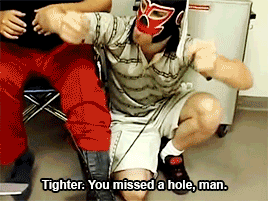

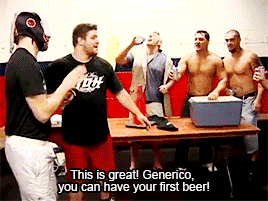








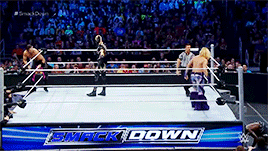






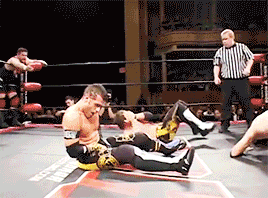
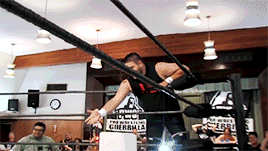


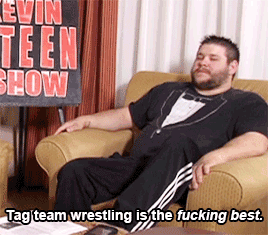
Tag team wrestling IS the fucking best. Also, another excellent essay Mith. Wonderful use of repetition. My favourite live wrestling experience involves Steen and Generico at Death Before Dishonor VIII in 2010, near the end of their ROH story, so I'm getting ahead of the story. Another example of flipping expectations and conventions however, as always, from those two.